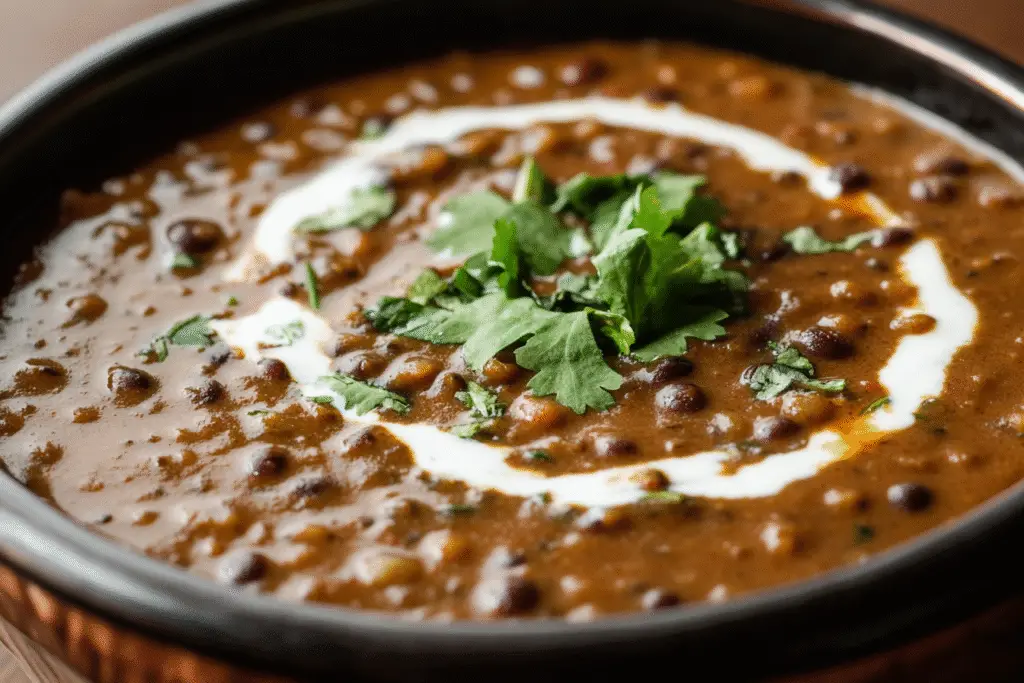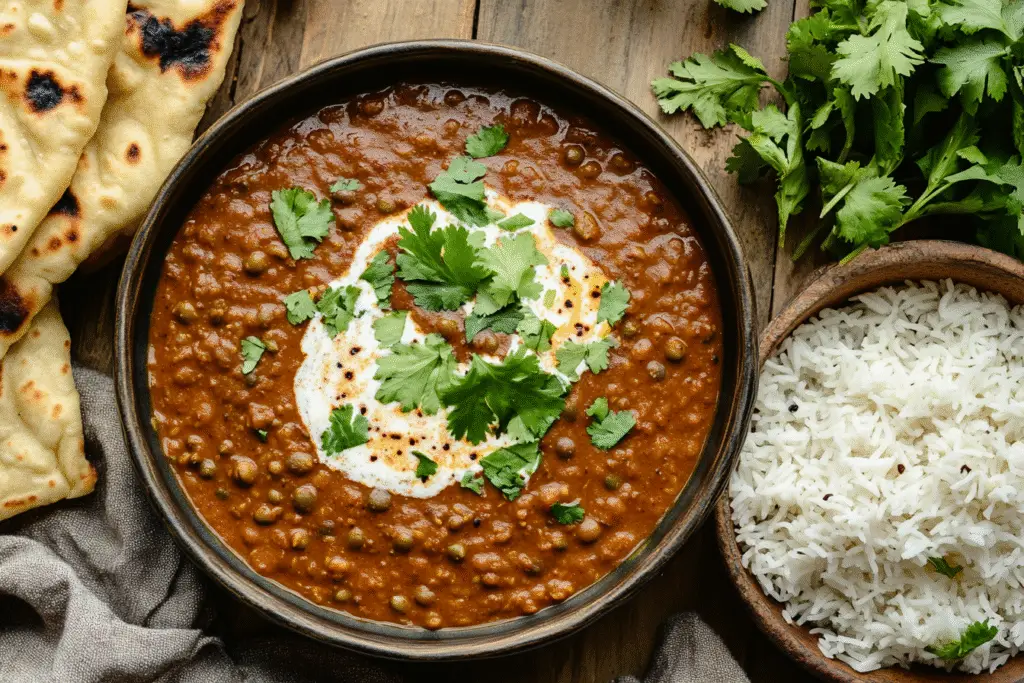The Unrivaled Comfort of Dal Makhani
Dal Makhani, often hailed as the crown jewel of Punjabi cuisine, is a deeply comforting, rich, and slow-cooked lentil dish that holds a special place in Indian households and restaurant menus alike. Known for its velvety texture and complex, buttery flavor, Dal Makhani literally translates to “buttery lentils.” Unlike simpler dal preparations, this dish is cooked slowly, allowing the flavors to deepen and the lentils to break down just enough to create a creamy, luxurious sauce.
Traditionally, Dal Makhani is a celebratory dish—served at weddings, festivals, and family gatherings—but it’s equally treasured as a soul-warming comfort food. It’s beautifully balanced: the slight earthiness of whole urad dal (black gram), the gentle heat from warming spices, the faint tang from tomatoes, and the richness from butter and cream all meld together in perfect harmony.
Making Dal Makhani at home allows you to adjust the richness, spice, and texture to your taste. Whether you’re aiming for the restaurant-style version or a lighter homemade take, it’s a dish that’s deeply satisfying and perfect for slow weekend cooking.
Choosing the Right Lentils: The Heart of the Dish
The lentils you use will directly influence the dish’s authenticity and texture.
Key Lentils:
- Whole Urad Dal (Black Gram): This is the primary lentil and provides the signature creamy texture. The skin gives an earthy depth, while the inside softens beautifully.
- Kidney Beans (Rajma): Added for contrast and texture. A small quantity balances the lentils and adds variety.
Important Note:
Do not substitute urad dal with split dals like toor dal or masoor dal. These cook differently and lack the characteristic creaminess of Dal Makhani.

Recommended Equipment for Perfect Dal Makhani
- Heavy-Bottomed Pot or Dutch Oven: Crucial for slow simmering without burning.
- Pressure Cooker or Instant Pot: Cuts down cooking time significantly while still achieving soft, tender lentils.
- Blender (optional): For smoothing the sauce if desired.
- Wooden Spoon or Silicone Spatula: To prevent scraping or damaging the pot during long cooking.
Common Mistakes and How to Avoid Them
1. Rushing the Cooking
Dal Makhani must simmer for at least an hour (or more) to develop its signature creamy texture. Skipping this step results in undercooked, gritty lentils and a flat flavor.
2. Skipping the Butter and Cream
Butter and cream aren’t optional if you’re aiming for authentic richness. You can adjust quantities, but omitting them altogether changes the essence of the dish.
3. Not Seasoning in Layers
Season with salt early during cooking, but adjust again at the end. The flavors need to build slowly throughout the simmering process.

Ingredient Swaps and Dietary Adjustments
- Vegan Option: Substitute butter with vegan butter or neutral oil, and cream with coconut cream or cashew cream. The dish will still be rich and delicious.
- Low-Fat Version: Use less butter and replace heavy cream with milk or half-and-half.
- Spice Adjustments: Dial back chili powder for a milder version or increase garam masala for a more fragrant dish.
Prep-Ahead and Time-Saving Tips
- Soak Lentils Overnight: This dramatically reduces cooking time and ensures the lentils soften properly.
- Pressure Cooker: Cuts cooking time from 1.5 hours to about 30–40 minutes.
- Make in Advance: Dal Makhani tastes even better the next day as the flavors continue to develop.
Flavor Enhancements and Pairing Ideas
- Smoked Finish: For authentic restaurant-style depth, you can briefly smoke the dal using a piece of hot charcoal and a drizzle of ghee, sealed in the pot for a few minutes.
- Garam Masala Finish: Stirring in garam masala at the very end keeps the spices fragrant.
- Serve with: Garlic naan, steamed basmati rice, or jeera (cumin) rice.
Pair Dal Makhani with simple vegetable sides like sautéed spinach, cucumber raita, or pickled onions to balance the richness.
Dal Makhani Recipe
Ingredients
For the Dal
- 1 cup whole urad dal (black gram)
- 1/4 cup red kidney beans (rajma)
- 4 cups water (plus extra for soaking)
- Salt, to taste
For the Masala Base
- 3 tablespoons unsalted butter (or ghee)
- 1 large onion, finely chopped
- 4 garlic cloves, minced
- 1 tablespoon fresh ginger, grated
- 2 green chilies, slit (optional)
- 2 medium tomatoes, pureed (or 1 cup canned crushed tomatoes)
- 1 teaspoon cumin seeds
- 1 teaspoon coriander powder
- 1 teaspoon garam masala
- 1/2 teaspoon turmeric powder
- 1 teaspoon Kashmiri chili powder (or mild paprika for less heat)
Finishing Touches
- 1/4 cup heavy cream (plus extra for drizzling)
- 1 tablespoon butter (optional, for extra richness)
- Fresh cilantro, chopped, for garnish
- Lemon wedges, for serving
Instructions
Step 1: Soak and Cook the Lentils
- Rinse urad dal and kidney beans thoroughly. Soak in plenty of water overnight or for at least 8 hours.
- Drain and add to a heavy-bottomed pot with 4 cups of fresh water and a generous pinch of salt.
- Bring to a boil, then reduce to a simmer and cook for about 1.5 to 2 hours, stirring occasionally, until the lentils are soft and creamy.
(Alternatively, cook in a pressure cooker for 30–40 minutes.)
Step 2: Prepare the Masala
- In a separate large pan, melt butter over medium heat.
- Add cumin seeds and let them sizzle for 30 seconds until fragrant.
- Stir in chopped onions and sauté for 8–10 minutes until golden and soft.
- Add garlic, ginger, and green chilies. Cook for another 1–2 minutes.
- Add pureed tomatoes, coriander powder, turmeric, garam masala, and chili powder. Cook for 10–15 minutes, stirring regularly, until the oil begins to separate and the masala deepens in color.
Step 3: Combine and Simmer
- Add the cooked lentils and kidney beans (along with their cooking water) to the masala.
- Stir well and bring to a gentle simmer. Cook uncovered for at least 45 minutes to 1 hour, stirring occasionally, until the dal thickens and becomes creamy.
(Add water as needed if it gets too thick.)
Step 4: Finish the Dal
- Stir in heavy cream and an extra tablespoon of butter if desired. Simmer for another 5–10 minutes.
- Taste and adjust salt as needed.
Step 5: Serve
- Garnish with fresh cilantro and an extra drizzle of cream.
- Serve hot with steamed basmati rice, jeera rice, or naan.
Storage and Reheating
- Storage: Dal Makhani can be refrigerated for up to 4 days in an airtight container.
- Reheating: Reheat gently on the stovetop with a splash of water to loosen the dal as it thickens upon cooling.
- Freezing: Freezes well for up to 2 months. Thaw overnight in the fridge and reheat slowly.
Troubleshooting Tips
- Dal Too Thick? Add warm water or milk to adjust consistency.
- Dal Too Thin? Simmer uncovered until it thickens to your liking.
- Lacking Flavor? Stir in a bit more butter, cream, or garam masala, and finish with a squeeze of lemon to brighten the dish.
Variations: Dal Makhani vs. Other Lentil Dishes
- Dal Makhani: Rich, slow-cooked, butter- and cream-based with black gram and kidney beans.
- Tadka Dal: Lighter, often made with yellow or red lentils, with a spiced oil tempering.
- Dal Fry: Faster-cooked, often with toor or masoor dal, typically thicker and more rustic.
Dal Makhani is unique for its luxurious texture, smoky undertones (when smoked), and celebratory richness.
Serving Suggestions
- Breads: Garlic naan, butter naan, or tandoori roti.
- Rice: Steamed basmati rice, jeera rice, or ghee rice.
- Sides: Fresh cucumber raita, kachumber salad, pickled onions, or crispy papadums.
- Accompaniments: Mango chutney or lime pickle for sharp, sweet contrast.
Dal Makhani pairs beautifully with light lagers, sparkling water with lemon, or a glass of lassi to balance its creamy richness.
